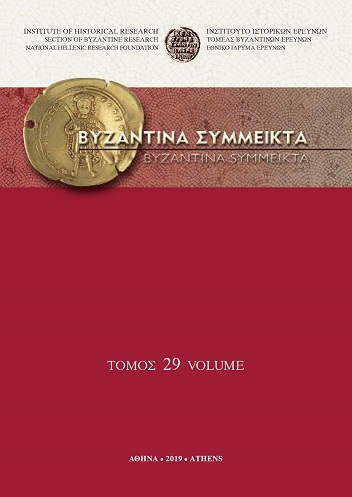Τεκμήρια της καθημερινής ζωής στο βενετικό Αιγαίο. Τα μεταλλικά ευρήματα των ανασκαφών στο Επάνω Κάστρο της Άνδρου (13ος – 17ος αιώνας)
Abstract
194
Evidence of Everyday Life in the Venetian Aegean:
The Metal Finds of the Excavations
in Epano Kastro of Andros (13th–15th centuries)
Epano Kastro (Upper Castle) is located on the southeastern part of
the island of Andros and was built by the Venetian sovereigns after 1205
(fig. 1). During the period 2004-2010 a research excavation into preeminent
parts of the castle was organized by the University of Athens and headed
by Assistant Professor Eleni Deliyianni-Doris (fig. 2). The metal finds,
mainly from copper alloys and iron, were serving the practical needs of
the inhabitants. Based on the archaeological context and mainly on the
subsidiary monetary finds, most of them date back to the period of the
Venetian rule on the island (1205-1566). They include: lockers (cat.: 1-7, fig.3), keys (cat.: 8-9, fig. 4), revetments (cat.: 10-11, fig. 5), lighting devices (cat.:12-15, fig. 6), fragments of vessels (cat.: 16-26, fig. 7), knives (cat.: 27-31, fig.8), utensils for spinning and sewing (cat.: 32-35, fig. 9), crossbow arrowheads(cat.: 36-39, fig. 10), firearm shots (cat.: 40-42, fig. 10), parts of horseshoes(cat.: 43-44, fig. 11), sockets (cat.: 45-49, fig. 12) and miscellaneous metal components (cat.: 50-54), including iron nails (fig. 13).
Article Details
- How to Cite
-
ΜΠΑΡΜΠΑΡΙΤΣΑ Ε. (2019). Τεκμήρια της καθημερινής ζωής στο βενετικό Αιγαίο. Τα μεταλλικά ευρήματα των ανασκαφών στο Επάνω Κάστρο της Άνδρου (13ος – 17ος αιώνας). Byzantina Symmeikta, 29, 141–194. https://doi.org/10.12681/byzsym.18941
- Issue
- BYZANTINA SYMMEIKTA 29
- Section
- Articles

This work is licensed under a Creative Commons Attribution-NonCommercial-ShareAlike 4.0 International License.
Copyright: The copyright for articles in this journal is retained by the author(s), with first publication rights granted to the journal. By virtue of their appearance in this open access journal, articles are free to use (with the exception of the non-granted right to make derivative works) with proper attribution for non-commercial uses (licence Creative Commons 4.0). NHRF retains the worldwide right to reproduce, display, distribute, and use articles published in BYZANTINA SYMMEIKTA in all formats and media, either separately or as part of collective works for the full term of copyright. This includes but is not limited to the right to publish articles in an issue of the Journal, copy and distribute individual reprints of the articles, authorize reproduction of articles in their entirety in another NHRF publication, and authorize reproduction and distribution of articles or abstracts thereof by means of computerized retrieval systems.



